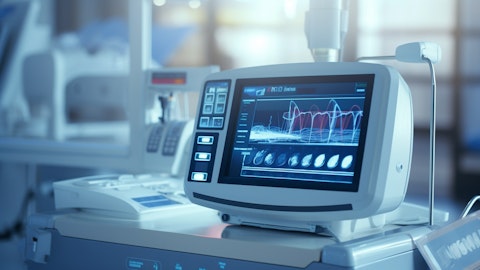Precipio, Inc. (NASDAQ:PRPO) Q1 2025 Earnings Call Transcript May 15, 2025
Operator: Welcome to the Precipio First Quarter 2025 Shareholder Update Conference Call. All participants will be in listen-only mode. [Operator Instructions] Please note that the conference is being recorded. Statements made during this call contain forward-looking statements about our business. You should not place undue reliance on forward-looking statements, as these statements are based upon our current expectations, forecasts and assumptions, and are subject to significant risks and uncertainties. These statements may be identified by words such as may, will, should, could, expect, intend, plan, anticipate, believe, estimate, predict, potential, forecast, continue or the negative of these terms, or other words, or terms of similar meaning.
Risks and uncertainties that could cause our actual results to differ materially from those set forth in any forward-looking statements include, but are not limited to, the matters listed under risk factors in our annual report on Form 10-K for the year ended December 31, 2024, which is on file with the Securities and Exchange Commission, as well as other risks detailed in our subsequent filings with the Securities and Exchange Commission. These reports are available at www.sec.gov. Statements and information, including forward-looking statements, speak only to the date they are provided unless an earlier date is indicated, and we do not undertake any obligation to publicly update any statements or information, including forward-looking statements, whether as a result of new information, future events or otherwise, except as required by law.

Now let me hand the call over to Ilan Danieli, Precipio’s CEO. Please go ahead.
Ilan Danieli: Good afternoon. And thank you all for joining us today to review Precipio’s financial and operational results for the first quarter of 2025. I’m pleased to report a strong start to the year in terms of year-over-year growth, improved margins and favorable regulatory developments. This is despite expected seasonal pressures in the first quarter, which impacted our quarter-over-quarter results. Let’s start with a breakdown of our Q1 financial performance. As you may have seen in our recent 10-Q filing, as well as the press release, revenues for Q1 2025 were $4.9 million, up 43% year-over-year, reflecting sustained demand and continued growth in our Pathology Services. However, this also represents a 9.5% decrease from Q4 2024, which we’ll explain in more detail shortly.
We continue to make significant progress in the following metrics year-over-year. Adjusted EBITDA improved by 92%, coming in at $108,000 loss this quarter, compared to $1.4 million loss in Q1 of last year. Cash use and operations improved by 93%, with a $44,000 cash reduction in Q1 2025, down from $667,000 cash reduction in Q1 of last year. Net cash used for the quarter was $372,000, a 49% improvement year-over-year. These results underscore the ongoing operational discipline and scalability we’ve built into our business. The sequential quarter-over-quarter decline in revenue from Q4 2024 doesn’t concern us, since this is a typical seasonal pattern we see across the healthcare industry, especially in diagnostics. As many of you know, insurance plans reset on January 1st, meaning deductibles are back to zero, and patients often postpone non-urgent testing until those out-of-pocket costs are absorbed.
Q&A Session
Follow Precipio Inc. (NASDAQ:PRPO)
Follow Precipio Inc. (NASDAQ:PRPO)
Receive real-time insider trading and news alerts
This behavior impacts test volumes and collections, which in turn creates a temporary dip in both revenue and cash flow. We anticipated this, and our results reflect a well-managed quarter in light of these dynamics. More importantly, we’re already seeing a rebound in Q2 and we expect to return to positive cash flow in either Q2 or Q3 of this year. On the Product side, last year’s FDA ruling on Laboratory Developed Tests, which was eventually overturned in March of this year, caused a number of our prospective customers to delay their plans to bring in our technology in-house until this was resolved. We’ll discuss that shortly as well. Now let’s review each of our two divisions in a bit more detail. We’ll begin with our Pathology Services division, and then turn to our Product division.
Our Pathology division continues to perform strongly. Test volume increased 46% and revenue grew 53% year-over-year. 11 new physicians began utilizing our services this quarter, a convenient sign of physician engagement and growing market trust. On the sales side, division growth has largely been accomplished by the same existing sales team that successfully tells the story of our mission to battle cancer misdiagnosis, presents our value proposition to customers and then allows our lab to deliver strong results. This means the company accomplished approximately 50% growth with no substantial increase in sales team headcount and related costs. Now I’d like to talk briefly about margins and operating expenses, where we’re proud to report continued operational improvement.
Pathology gross margins increased from 24% to 42% year-over-year. This is due to the increased volume of cases, which translates into further scale efficiencies in the lab. Let me give one example from the lab, which will demonstrate that in fact. Most laboratory tests are performed in batches, meaning multiple patient samples are tested together in the same run. Each batch has a certain number of elements that create a fixed cost for that batch, regardless of how many samples are run in that batch. One of those elements is called a positive control, which is a known positive sample used to verify that the test correctly identifies a positive result. This control sample costs money to produce, but of course it doesn’t generate revenue, and therefore, it adds to the cost of the batch.
The cost of that positive control is spread over all actual patient samples run in that batch. If, for example, the cost of the control is $200, and we run five samples in a batch, then $40 is added to the cost of each sample in the batch. However, if we run 20 samples per batch, then the additional cost per sample drops to $10, which in turn improves gross margins. Now, this makes the question, why not always run 20 batches of 20 samples, right? Well, depending on the number of samples the lab receives for that test every day, that decision will impact the turn-on time the lab wants to provide to its customers. If the lab receives on average two samples per day, then it will take 10 samples — 10 days to fill the bus, and that might be longer than the service level that the lab has promised to its customers.
Conversely, when a lab’s volume increases, then it inherently takes less time to fill a batch and the lab can maintain the same level of service while running larger batches. This is one factor that contributes to our increased margins. These improvements are driven by a combination of operational efficiency, improved cost management and scale. Going forward, we expect Pathology division margins to stabilize in the mid-40%s range. We also saw meaningful improvement in operational efficiency. Operating expenses as a percent of revenue drops from 87% to 61%, a 30% improvement year-over-year. This is achieved by keeping operating expenses flat at approximately $3 million per quarter, while growing revenue by 43% year-over-year. How have we driven this margin growth?
We achieved margin improvement through strategic investments in two key areas, equipment and people. With respect to equipment, we’ve always insisted on investing in state-of-the-art equipment in our labs, which ensures the highest quality, directly impacting patient outcomes. The cost of each piece of equipment is divided by the number of samples run during the life of the machine to get a cost per sample, which is then burdened on each phase of the sample. As our volume increases, this fixed cost is spread over more samples and reduces the cost per sample, thereby improving gross margins. Equal improvement is our investment in talent. We invest heavily in the training of our staff to ensure they have both the highest quality and skill set and are able to conduct their work accurately and efficiently.
This translates into many factors. I’ll give two examples. First of all, a better trained lab employee is able to handle more samples for batch, which drives and improves efficiencies in batching, as we discussed before. Second, our team is constantly handling very expensive reagents, which require delicate and accurate work. Sometimes a mere two drops of one of our reagents can cost $1,000 and those drops need to be pipetted accurately into the right tube. If they’re not, with one small pipette push, we just wasted $1,000. As our business and volumes grow, the value of the excellent skill set of our lab tech directly impacts the financial performance of our business. These are just a few examples that reflect our continued commitment to sustainable, disciplined, operational and financial management.
Next, I’d like to address a major Medicare reimbursement development that will increase our cash receipts from existing testing. In Q1 of this year, we received MolDx approval for our next-generation sequencing or NGS testing, a major regulatory milestone for Precipio. For those unfamiliar, MolDx is the Medicare program that governs molecular diagnostic test reimbursement in various states across the U.S. Securing approval for MolDx is a rigorous and highly selective process, requiring laboratories to submit an application with robust data to support clinical validity, utility, accuracy and reproducibility. Without MolDx approval, when a laboratory receives Medicare patient samples for NGS testing from MolDx -governed states, the lab does not get paid.
Up until now, when we received patient cases from a state governed by MolDx and NGS was part of the test order for that sample, we ran the NGS component of the order and ate the cost, knowing we could not bill for NGS for a sample from this MolDx state. This meant that each month, we had dozens of tests where we incurred the cost of running it, but received no revenue. Now, with this approval, going forward, we will still be running the same tests, but we will be able to bill and collect cash for them. This will impact the revenue recognized, as well as cash received. Based on our internal estimates, this would equal — this could equal approximately a $250,000 [ph] per quarter in increased revenue or cash from our current case volume. That is before any growth.
Overall, the Pathology Services division is growing at a healthy pace and is a positive revenue and cash contributor to the overall business. With continued volume increases, we expect to see gross margins and contributions improve. Moreover, as we discussed before, this division is critical to the continued development of our Product division. With over 12,000 samples received in 2024, this enables us to continuously test, develop and launch new products for our Product division. We’ve essentially built a self-financed R&D operation that can rapidly and at a very low cost develop our next-generation of products. Now, let’s turn to the Product division in a bit more granularity. In Q1, we onboarded one new customer and launched two new diagnostic panels, and two customers began evaluation for four additional panels collectively.
With that pipeline, we expect order volumes to increase steadily in Q2 and beyond. We also saw a positive trend in customer meetings driven by distributors, an early signal that our investment in these sales channels is gaining traction. One of the factors that slowed down our growth was the uncertainty around the FDA ruling on laboratory tests or LBPs as they’re called, which was finally cleared up in March of this year when that ruling was overturned. Our products, such as HemeScreen fall under the LBP category. And last year, the FDA came out with a ruling that essentially began the gradual elimination of LBPs and conversion of all laboratory testing to FDA-approved kits. This would have placed an enormous cost burden both on manufacturers such as ourselves to create and submit such kits for approval and on laboratories who would have to comply with these rulings.
It also placed an insurmountable burden on the FDA itself, which would have to review and approve all these submissions. In March of this year, the FDA ruling was overturned, and the industry breathed a sigh of relief. Many of our own customers told us that their consideration of our products would not hold until the FDA situation cleared up. And indeed, once the reversal of that ruling came out, some of our prospective customers reached back out to us saying they are now ready to proceed. With our pipeline of prospective customers that are now at various stages of validation and are expected to go live commercially in Q2 and beyond, we’re expecting to begin to see consistent growth in Product revenues in Q2 and further in the year. Now let’s turn to Product operations.
Gross margins for the Product division improved from 37% to 51% year-over-year. I’d like to describe as an example one of the factors that contributed to this improvement. One factor that drives these cost improvements is called shelf life quality control. Each time we produce a batch of Product which has a committed shelf life, we set aside a number of plates for internal testing to ensure quality control. For instance, to ensure our Product maintains a six-month shelf life, we test a couple of plates from the same production batch each month. So let’s say we produce 100 plates, we would reserve 12 plates of them for this shelf life testing, testing two plates each month over a period of six months for a total of 12 plates. That equals 12% of the manufactured batch which we don’t sell but rather use internally for quality control.
But now if we produce 200 plates in a production run, we still only need 12 plates for shelf life testing. Now that quality control testing has utilized only 6% of the batch instead of 12% and we just made a 6% margin bump. As production scales, the cost of quality control per unit drops and that helps drive up our gross margin. This is just one example but it shows how growing demand and higher output lead to better efficiency and profitability. For the entire combined business, gross margin grows from 27% to 43% year-over-year. This is a weighted average calculation of our gross margins of both divisions together. And since the Product side is operationally similar than the Pathology Services side and it has a lot more room to grow in terms of margins, as the Product side of the business begins to grow faster than the Services side, we will see the overall company gross margins continue to increase.
We’re making a big push to grow our Products customer base, panel use and subsequent revenue. So Q4 2024 to Q1 2025, our revenues were flat. One of the key factors that has been largely out of our control is the timeline it takes our customers to complete the validation and go live with our Products, which means they then begin to consistently place recurring orders. As an example, we are currently in the process of onboarding a major laboratory that has decided to replace their current testing and has selected five out of our six panels that we offer. In Q2 of this year, they began validation for the first panel and we hope they will be able to complete and go live with the second panel by the beginning of Q3. We anticipate that this customer could reach full operating capacity by the end of the year, representing a potential seven-figure annualized revenue.
There are more stories like this in our pipeline, but unfortunately, oftentimes as a manufacturer, we have limited ability to influence these timelines as much as we’d like to. Therefore, in order to shorten that timeline, we’ve created several structured plans to support and encourage a more efficient and rapid onboarding process. These programs improve the commercial terms for customers who complete validation on a timely basis and transition to routine use. In most cases, we find that these discounts are earned back within one quarter and accelerate customer activation and revenue realization. We will continue to track the impact of these initiatives and look forward to sharing progress in future updates. Now, I’d like to update you on two items that have a positive yet non-recurring impact on both cash and profits during 2025.
First, Change Healthcare, the billing platform we rely on for processing a substantial portion of our patient claims and whom in early 2024 experienced a cyberattack that temporarily shut down key systems for providers nationwide. Like most healthcare providers, we too were affected. The disruption caused delays in billing, reimbursement and impacted our collections during the first half of 2024. To help bridge the gap, we received approximately $1.1 million through Change Healthcare’s Temporary Funding Assistance Program. These funds were interest-free, offering important short-term relief while Change Healthcare worked to restore its systems, which they confirmed as fully operational in late October 2024. Following the system restoration, we entered in discussions with Change Healthcare about settling up.
First, we negotiated a write-off of $130,000 to offset costs incurred as a result of their problems. Second, we negotiated the one-year repayment of the funds they advanced. Since the beginning of the year, we’ve repaid approximately $200,000, Change Healthcare has written off the $130,000, and the remaining obligations, just under $800,000, will be paid out over the year. The second positive non-recurring impact on both cash and profits was our recent receipts of over $400,000 of COVID relief funds from the Treasury. As you may recall, part of the federal government’s response to COVID-19 was the CARES Act, which included an employee retention credit to help companies like ours offset payroll tax expenses during the pandemic. Based on the eligibility criteria back in November 2022, we submitted a claim for approximately $1.4 million.
Last month, we received the first installment of that credit of around $400,000. To be honest, we didn’t expect to reduce money at all, at least not without significant delays or complications. We’re still pursuing the remaining $1 million and are taking all appropriate steps to ensure that we receive those funds. Together, these two items result in a non-recurring income of over $0.5 million, which will be recorded in our second quarter results and make our remaining obligations to Change Healthcare much easier to fulfill. Looking ahead to the remainder of 2025, we expect revenue growth to continue in Q2 and accelerate in the second half of the year, particularly on the Product side, as we continue to add new customers and recurring revenue and expand existing customer purchases of new panels.
We also anticipate returning to positive operating cash flow in Q2 or Q3, driven by higher Pathology volumes, increased Product sales and the NGS Medicare reimbursement previously discussed. In closing, we sit here today with a strong Pathology business, great prospects for our Product pipeline and a strong balance sheet. We appreciate the continued support of our shareholders and look forward to a strong Q2 and continued momentum throughout the year. Thank you and have a nice evening.
Q – :
Operator: The conference is now concluded. Thank you for attending today’s presentation. You may now disconnect.
Follow Precipio Inc. (NASDAQ:PRPO)
Follow Precipio Inc. (NASDAQ:PRPO)
Receive real-time insider trading and news alerts



